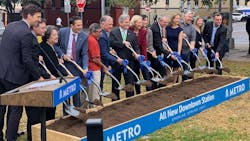Cap Metro holds groundbreaking ceremony for new Downtown MetroRail Station
Capital Metro (Cap Metro) held a groundbreaking ceremony for MetroRail's new Downtown Station on March 25 with construction slated to begin on the two-year project the first week of April.
Capital Metro explains that the current Downtown Station is the busiest, but smallest of its nine stations. The $37-million new station will provide a larger and improved permanent MetroRail station with two platforms, allowing for increased capacity. The new structure will also improve customer amenities with custom canopies, ticketing, seating and digital messaging boards.
The new station is scheduled to open in the spring of 2021 and Cap Metro says it will serve as a public gathering space and mobility hub, providing connections between MetroRail and other transportation modes, including other Cap Metro service, B-cycle and Car-2-Go.
The new Downtown Station will be located on 4th St. between Neches St. and Red River St., one block east of the current station. The project was initiated by receipt of a $50 million grant in 2014 from the Texas Department of Transportation (TxDOT). Partnerships for the station include TxDOT and city of Austin, which will provide utility upgrades to the station. In February, Cap Metro awarded a $36.8 million contract to Jay-Reese Contractors for construction of the station.
“Building a great public transit network is only made possible through strong relationships and partnerships, and this new station is a major step toward helping ease congestion and creating a more connected region,” said Capital Metro Board Chair Wade Cooper.
New enhancements to MetroRail, also known as the “Red Line,” are included in Project Connect, a long-term vision plan for public transportation in Central Texas. The plan calls for a comprehensive redevelopment of the area's transit network, and it's being conducted in partnership with other mobility and transportation agencies, including the city of Austin, Travis County, Texas Department of Transportation, Capital Area Rural Transportation System, Central Texas Regional Mobility Authority and the Federal Transit Administration.
About the Author

Mischa Wanek-Libman
Group Editorial Director
Mischa Wanek-Libman is director of communications with Transdev North America. She has more than 20 years of experience working in the transportation industry covering construction projects, engineering challenges, transit and rail operations and best practices.
Wanek-Libman has held top editorial positions at freight rail and public transportation business-to-business publications including as editor-in-chief and editorial director of Mass Transit from 2018-2024. She has been recognized for editorial excellence through her individual work, as well as for collaborative content.
She is an active member of the American Public Transportation Association's Marketing and Communications Committee and served 14 years as a Board Observer on the National Railroad Construction and Maintenance Association (NRC) Board of Directors.
She is a graduate of Drake University in Des Moines, Iowa, where she earned a Bachelor of Arts degree in Journalism and Mass Communication.
